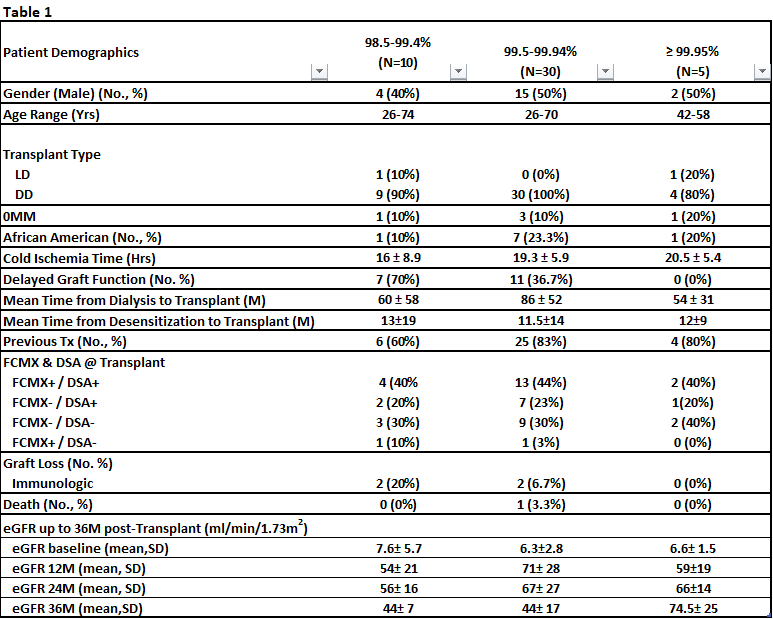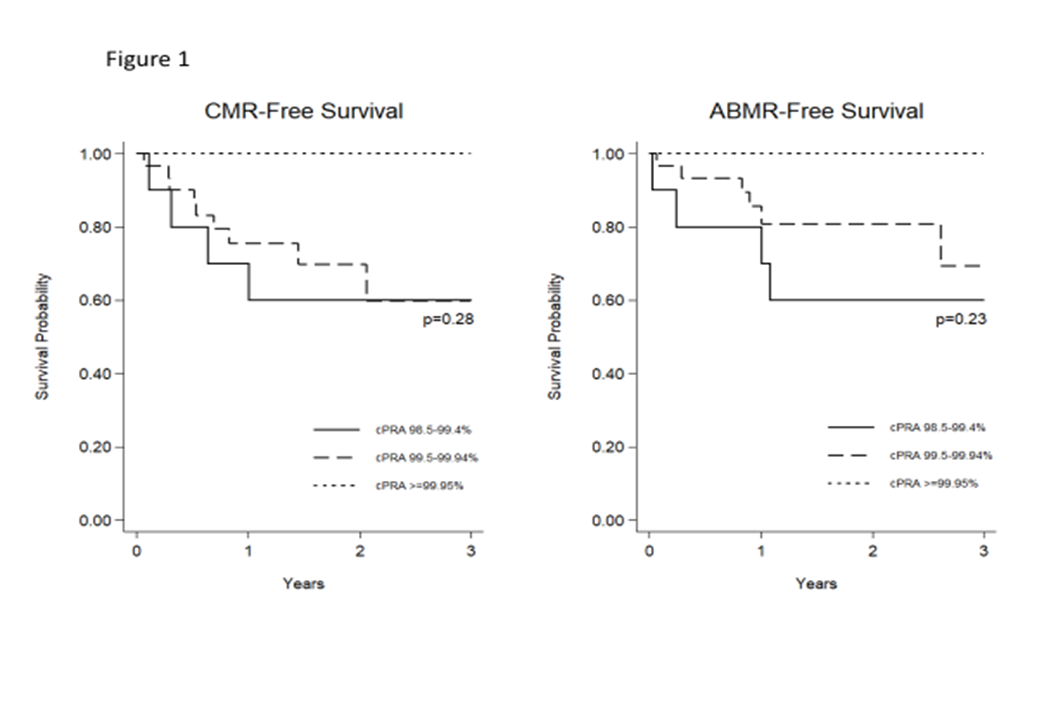Outcomes of HLAi Transplant in CPRA 98-100 after Desensitization: Single Center Experience
1Cedars Sinai Medical Ctr, Los Angeles, CA, 2Pathology, Cedars Sinai Medical Ctr, Los Angeles, CA
Meeting: 2020 American Transplant Congress
Abstract number: 570
Keywords: Allocation, Highly-sensitized
Session Information
Session Name: Kidney Immunosuppression: Desensitization
Session Type: Oral Abstract Session
Date: Saturday, May 30, 2020
Session Time: 3:15pm-4:45pm
 Presentation Time: 3:39pm-3:51pm
Presentation Time: 3:39pm-3:51pm
Location: Virtual
*Purpose: The new KAS implementation aimed at increasing equity in organ allocation for broadly sensitized (HS) patients. However, recent data shows that for the most HS (>99.5%) there has been no improvement in transplant rates. We hypothesize that combining desensitization (DES) + KAS will likely improve transplant rates and outcomes. Here we report our experience transplanting HS patients after DES.
*Methods: HS patients underwent DES with IVIG+rituximab ± PLEX ± Tocilizumab. Acceptable CMX criteria for transplantation included: Negative CDC, T&B-cell FCMX ≤225MCS and DSA ≤10,000MFI post DES. Unacceptable antigens were defined as MFI>15,000. Outcomes included rate of ABMR, patient & graft survival & eGFR were recorded up to 36M. All transplanted HS patients received induction with alemtuzumab and maintained with tac/mmf/pred.
*Results: From 2016 to present, 45 HS patients {G1: CPRA 98.5-99.4% (N=10), G2: CPRA 99.5-99.94% (N=30), and G3: CPRA>99.95% (N=5)} received HLAi transplants. Briefly, mean time from dialysis to transplant was G1: 57±59M, G2: 86.2±52M vs. G3: 57±59M and mean time from desensitization to transplant was G1: 13±19M vs. G2: 11±14M vs. G3: 12±9M, respectively. Previous transplant was 60% vs. 83% vs. 80%. 40% of patients in each group had FCMX+ & DSA+ at transplant (Table 1). Figure 1 shows CMR and ABMR free survival. No significant differences were seen in CMR or ABMR rates at 36M. Graft loss from ABMR was 20% (G1) vs. 7% (G2) (both d/t immunologic loss) vs. 0 (G3). Patient survival was 100%, 97% and 100%. eGFR @12M, 24M and 36M were G1: 54±21, 56±16, and 44±7 vs. G2: 71±28, 67±27, and 44±17 vs. G3: 59±19, 66±14, and 74±25 (ml/min/1.73m2) respectively.
*Conclusions: Rates of kidney transplantation among the HS patients at our center increased when combined with DES. Even with DES, higher rate of rejections were seen in G1 and G2, primarily in the 1st year post-tx. Despite this, patient and graft survival were excellent and eGFRs were acceptable at 36M, demonstrating the importance of both desensitization & allocation policy in facilitating successful transplantation.
To cite this abstract in AMA style:
Vo A, Huang E, Haas M, Williamson S, Meyers C, Peng A, Najjar R, Sethi S, Ammerman N, Lim K, Gillespie M, Jordan SC. Outcomes of HLAi Transplant in CPRA 98-100 after Desensitization: Single Center Experience [abstract]. Am J Transplant. 2020; 20 (suppl 3). https://atcmeetingabstracts.com/abstract/outcomes-of-hlai-transplant-in-cpra-98-100-after-desensitization-single-center-experience/. Accessed December 14, 2025.« Back to 2020 American Transplant Congress


